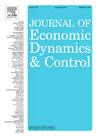A tractable model of epidemic control and equilibrium dynamics
IF 2.3
3区 经济学
Q2 ECONOMICS
引用次数: 0
Abstract
We develop a single-state model of epidemic control and equilibrium dynamics, and we show that its simplicity comes at very low cost during the early phase of an epidemic. Novel analytical results concern the continuity of the policy function; the reversal from lockdown to stimulus policies; and the relaxation of optimal lockdowns when testing is feasible. The model's enhanced computational efficiency over SIR-based frameworks allows for the quantitative assessment of various new scenarios and specifications. Calibrated to reflect the COVID-19 pandemic, the model predicts an optimal initial activity reduction of 38 percent, with subsequent stimulus measures accounting for one-third of the welfare gains from optimal government intervention. The threat of recurrent infection waves makes the optimal lockdown more stringent, while a linear or near-linear activity-infection nexus, or strong consumption smoothing needs, reduce its stringency.
一个易于处理的流行病控制和平衡动力学模型
我们开发了流行病控制和平衡动力学的单状态模型,并且我们表明,在流行病的早期阶段,它的简单性以非常低的成本获得。新的分析结果涉及政策功能的连续性;从封锁转向刺激政策;在可行的情况下放松最佳封锁。与基于sir的框架相比,该模型提高了计算效率,可以对各种新场景和规范进行定量评估。该模型经过校准以反映COVID-19大流行,预测最优的初始活动减少38%,随后的刺激措施占最优政府干预带来的福利收益的三分之一。复发性感染波的威胁使最佳封锁更加严格,而线性或近似线性的活动-感染联系,或强烈的消耗平滑需求,降低了其严格性。
本文章由计算机程序翻译,如有差异,请以英文原文为准。
求助全文
约1分钟内获得全文
求助全文
来源期刊

Journal of Economic Dynamics & Control
ECONOMICS-
CiteScore
3.10
自引率
10.50%
发文量
199
期刊介绍:
The journal provides an outlet for publication of research concerning all theoretical and empirical aspects of economic dynamics and control as well as the development and use of computational methods in economics and finance. Contributions regarding computational methods may include, but are not restricted to, artificial intelligence, databases, decision support systems, genetic algorithms, modelling languages, neural networks, numerical algorithms for optimization, control and equilibria, parallel computing and qualitative reasoning.
 求助内容:
求助内容: 应助结果提醒方式:
应助结果提醒方式:


